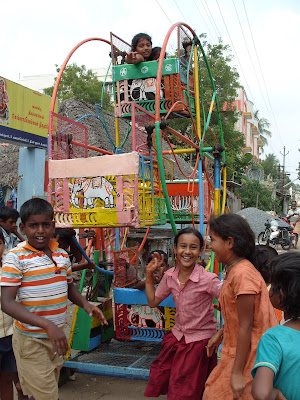December 11th, 2010
After more than 7 or 8 excruciating hours in the taxi from Delhi, the road sign finally came at around midnight:
How does one have a highway sign for the holy land of Vrindavan? Vrindavan is not so much a geographic location as a place of the heart. So every time I see that sign, I never cease to shake my head in wonder.
Then we passed the magnificent Krishna Balaram temple, whose white marble spires seemed to glow against the black silk of the night sky. All was quiet. We turned down the tiny alley which leads to the MVT guesthouse and the taxi rumbled to a stop.
We all let out huge sighs, as if exhaling the 24 hours of travel in our blood.
I remember how long ago, I once envisioned that when I would finally enter Vrindavan for the first time, I would get out of the car and roll in the dust, weeping. That's the traditional vision of someone who has longed to visit the holy land and has finally arrived.
But when I came to Vrindavan for the first time two years ago, I was overwhelmed by the hustle and bustle and repulsed by all the noise and pollution. I thought, rolling on the ground is definitely reserved for the saints.
But tonight was quiet. When I stepped out of the taxi, I felt overcome by a spontaneous desire. I slipped off my shoes and knelt right there on the cobblestone ground. The cold of the stones seeped through my clothes and pressed against my fingers and forehead. I savored the chill. I breathed in deep - I could smell the rich scent of cow dung and dust and smoke in the ground.
I didn't want to get up. I just wanted to keep kneeling and keep breathing in the scent of Vrindavan.
***
Related Posts:
Mystic Moment: I sit upon the stone ledge in the temple of Radha Raman. The sun slants through the courtyard and holds my face...
Refuge: It was my last night in Vrindavan, and I wound my way through the bustling temple grounds to the rooms of Srila Prabhupad. When I entered, I felt washed with that clean scent of home; wherever Srila Prabhupad resides is where my heart finds refuge...
***
Related Posts:
Mystic Moment: I sit upon the stone ledge in the temple of Radha Raman. The sun slants through the courtyard and holds my face...
Refuge: It was my last night in Vrindavan, and I wound my way through the bustling temple grounds to the rooms of Srila Prabhupad. When I entered, I felt washed with that clean scent of home; wherever Srila Prabhupad resides is where my heart finds refuge...






























